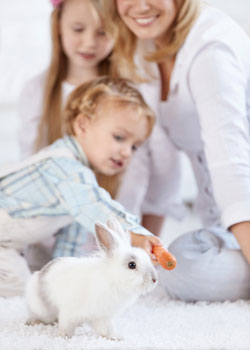Enrichment for rabbits
 Environmental enrichment is improving the area in which your rabbit lives by providing a choice of:
Environmental enrichment is improving the area in which your rabbit lives by providing a choice of:
- activities
- housing areas
- foraging opportunities
- socialisation.
Environmental enrichment is aimed at improving your rabbit's quality of life — their welfare.
Environmental enrichment includes everything from handling and socialisation with other animals, rabbits or humans, to the provision of toys. Environmental enrichment should:
- increase the variation in your rabbit's daily life
- encourage the expression of natural behaviours.
Environmental enrichment is designed to help your rabbit cope with its environment. It is especially important if you leave your rabbit for long periods of the day (more than 4 hours at a time) on its own.
Why is enrichment important for rabbits?
Rabbits are active, inquisitive, social and intelligent animals. Rabbits can become bored easily and their welfare suffers. Pet rabbits are often kept confined for a large proportion of time each day. They need control over their environment and what they can do to avoid boredom and stress.
Enrichment for rabbits
Enrichment should be tailored to suit your rabbit's environment and them. For example, if you have a small hutch or cage, you could build a larger pen to open your hutch out onto. This will encourage your rabbit to explore and exercise. A big floor area and high ceiling allows opportunities for normal behaviours such as:
- running
- jumping
- hopping
- rearing up on their hind legs.
All environmental enrichment should take into consideration the mental and the physical stimulation you can give your rabbit. Make sure materials used are non-toxic and have smooth, rounded edges. With all enrichment items you must regularly inspect them for damage and potential injury points. Repair, discard or replace any items that are damaged or dangerous.
Ideas for environmental enrichment for rabbits include:
- Hiding places and platforms in their hutch.
- Toys and objects to manipulate, investigate, encourage play and allow digging and scent marking. Toys can be purchased from pet shops or online. It is important to have several toys that you rotate. Do not put them all in your rabbit's hutch or pen at once and just leave them there. They will become boring very quickly.
- Dietary enrichment — provide food in a way that encourages your rabbits to forage for or work for their food. An example might be a treat ball filled with little pieces of carrot or other food. Another example might be hiding leafy greens throughout their hutch, under hay and in hiding spots to encourage them to forage
- Positive interactions with humans — this includes playing games, grooming your rabbit and training your rabbit using positive reward-based methods such as clicker training.
If you have more than one rabbit, ensure there are enough items for all the rabbits. This will avoid fighting or rabbits missing out.
Do not fill your rabbits' enclosure with so many enrichment items that they can't exercise easily.